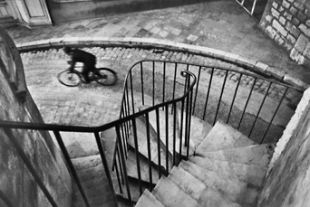
Waiting for the Future by Jens Olof Lasthein
This series of photos by Jens Olof Lasthein won Leica’s Oskar Barnack Prize in 2010. I absolutely love the first image in the series. The story it tells and the tones and colors in which it tells that story are magnificent.

Why People Photograph by Robert Adams
This is a slim little book of essays by photographer Robert Adams. I’ve often thought that the best writing about art comes not from professional critics and academics but from true fans or people who actually practice the art form about which they’re writing. Adams’s book only supports that opinion. My favorite line: “[Photographers] may not make a living by photography, but they are alive by it.”

Original Crown Mill Stationery
I first discovered this paper at Flax in Westwood in 2004. It’s since become my favorite paper for letters whether handwritten or laser printed, and it works well with a variety of inks.

Days with My Father by Phillip Toledano
Days with My Father is photographer Phillip Toldeano’s loving remembrance of his father. It’s beautifully shot and incredibly moving. To say anything more would intrude on the experience of encountering it for the first time.

Selima Rivington sunglasses
These sunglasses that Selima designed for Jack Spade and J.Crew offer a modern take on the classic Wayfarer design without the unfortunate branding or the unfortunately large lenses.

Once by Wim Wenders
I adore this book of photographs and text by Wim Wenders, much of which he shot while doing research for his films, which include Wings of Desire, Paris, Texas, and Buena Vista Social Club. Its title comes from the idea that photos don’t create ongoing moments, to steal the title of Geoff Dyer’s book; more than anything, they tell you that this happened once and will never happen again. Wenders concludes his volume:
“Once is not enough,”
I used to say as a kid.
That seemed very plausible to me,
“once upon a time.”
But when you take pictures,
I learned,
none of that applies.
Then once is
“once and for all.”

Comptoir de l’image
This store in the middle of the Marais in Paris could be notable for its collection of Vogue back issues alone. But it also happens to have an excellent selection of old photography books and is not to be missed if you’re in Paris and care at all about visual culture, fashion, photography, or seeing.
Comptoir de l’image 44 rue Sévigné, 75003 Paris

Henri Cartier-Bresson: The Modern Century
This exhibit, curated by Peter Galassi at MoMA in New York and currently in San Francisco, is an excellent retrospective of Cartier-Bresson’s work—the earliest of which makes possible so much of what has photographically come after. In a time when photojournalism needs to defended against skepticism, this exhibit is, perhaps, the best argument we have for its importance and relevance. You cannot come away from it as anything but a believer in photography.
Katell Keineg and The Gulf of Araby
I first heard “The Gulf of Araby” on Natalie Merchant’s live album in 2000, and was immediately struck by the sadness and poetry of Keineg’s song. It’s epic in its scope, unlike pretty much every song you’ll hear this year. When I moved back to the US in 2001, I immediately bought all of her albums and listened to them, like any new albums back then, for a couple weeks before setting them aside for a while. A while turned into years—until my friend Darcy wrote a cover story about Keineg for the New York Times Magazine in 2006. She was finally getting the recognition she had so long deserved, I thought at the time. But the next year NPR ran a story titled, “A Long Career on the Brink of Fame.” The popularity for which she seemed destined, especially after the Times profile, never arrived. But that’s her potential audience’s shortcoming, not hers.

Andy Spyra Photography
There’s a tough, gritty quality to Andy’s photojournalism that is palpable and classic. Much of his work, including this photo essay in the Independent, comes from Bosnia.
Daniel Milnor On Shooting Film
I started shooting film last year, and I enjoyed this little video about Daniel Milnor’s own experience with returning to film. Also worth checking out is Milnor’s blog.

The Art of Fiction: Jonathan Franzen in Paris Review 195
Jonathan Franzen’s interview cuts to the core of my rising distaste for technology “which provides endless distractions and encourages the endless pursuit of more goods…antithetical to the project of literature, which is to connect with that which is unchanging and unchangeable, the tragic dimension of life.”